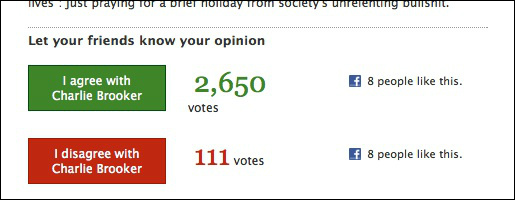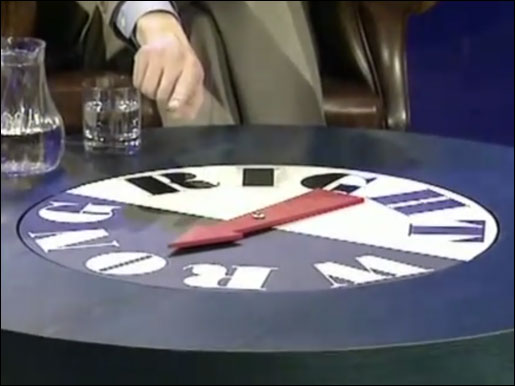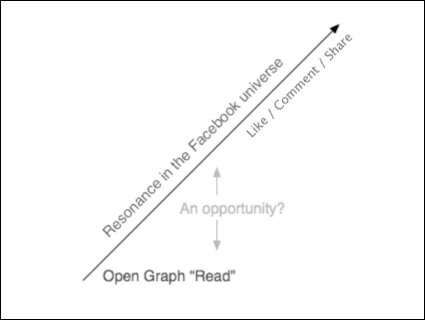I “Agree/Disagree” with reaction buttons in Facebook apps
A few weeks ago I spotted a tweet by Gary Ellis of Razorfish criticising “naff, lazy functionality” in the Guardian Facebook app, namely the “Agree/Disagree” buttons that appear on comment pieces. “Bit like the ‘Right/Wrong’ dial from Brass Eye” he said.

Agree/Disagree buttons in the Guardian Facebook app

The “Right/Wrong” table on Brass Eye
So why do it?
Adding meaning into the Open Graph
Actions in the Facebook universe carry different weights. Leaving a comment is right up there at the top of the scale, whereas posting an automatic “read” is right at the bottom, with Like and an organic share somewhere in between.

There is an opportunity to post more interesting actions into the Open Graph than “Read”
I’m interested in how you can use the potential of verbs in the Open Graph to socially capture reactions and actions by people to content from news organisations. It seems to me that there are plenty of gaps in that scale that could be filled by custom actions that allow Facebook users to express themselves to their friends, and that “Agree/Disagree” might fit in quite nicely.
A lack of nuance
It isn’t the most sophisticated approach to debate though. Big green and red buttons certainly lack nuance. We tried to set up some rules that would only make the buttons appear where appropriate. An article had to have been written in the sport or comment section, be tagged with the tone “Comment”, and be open for users to leave comments on the Guardian website.
That sort of works, with some rough uncomfortable edge cases.
The logic doesn’t handle joint bylines very well - especially if two people have been set up to debate a point. And sometimes headlines don’t really set up a premise which can be agreed with or disagreed with. And sometimes, if the headline is “The rape and genocide of the people of Syldavia is a bad thing” you don’t really want people saying “I disagree”. But I always take the view that, if an article is open for comment, then you’ve already opened up the space for a Bordurian to say “those Syldavians are getting what they deserve”.
Giving voice to the silent majority
I wanted the “Agree/Disagree” button to give a voice - or at least a click - to the silent majority. In comment threads underneath news pieces you seldom see people simply post “Great article”, “Thanks”, “I totally agree” and so forth. Instead people are much more inclined to pass comment when they disagree with the author, the viewpoint, or the news itself. This can easily lead to the impression that every single comment piece published by a paper is ill-researched, badly written, and taking a position in opposition to most of the people who use the website.
A single click of “Yep, I agree with that” is significantly less effort than writing a whole comment, and I reasoned that since the “Agree/Disagree” score count is higher in the interface than the comments, you would pick up a feeling for audience sentiment about an article before delving into the comments. In the first few weeks after launch we found that “Agree” consistently outscored “Disagree” by around 5:1.
Carrying the water
What fascinates me about publishing news in the Facebook environment is how you can distribute content, and your news values, to people who might otherwise never see your journalism.
For example, User A pressing the “Agree/Disagree” button on a Guardian story in Facebook publishes a story into their timeline. Their friend, User B is able to Like or comment on that action without reading the original article. That Like or comment may be seen by User C - who comments on the comment. That comment might be seen by their friend, User D, who clicks on the link and visits the Guardian. User D would never have been exposed to that story without the interactions in the middle.
Open Graph actions like “Agree/Disagree” enable the transmission of content. Sharing with my friends the statement “Martin Belam agrees with David Gilbertson that ‘Britain’s police are at war with the people’” is much more powerful than “Martin Belam read ‘Britain’s police are at war with the people’” and a lot less ambiguous than “Martin Belam likes ‘Britain’s police are at war with the people’”.
Rather like a chain of people passing along buckets of water to put out a fire, only the person who fills the bucket and the person who empties it ever need to interact with the water - everybody else in the chain only needs to interact with the bucket.
Would you try it again?
Absolutely.
I’d much rather launch a product where 0.1% of the articles are slightly editorially off-key, and have a “kill switch” in hand, than not launch at all until I’ve investigated every single possible outcome. We designed, built and launched the “Agree/Disagree” functionality using two developers, a QA tester and myself in two-and-a-bit days. It was a very low cost experiment in adding meaning to Open Graph actions around news.
You learn nothing about user behaviour whilst your plans are sitting on the drawing board.
“Facebook: The rise and rise of a social media giant”
Edited by Martin Belam
In February 2004, whilst at Harvard, Mark Zuckerberg and friends created “The Facebook”. What started as just a website for one university has become one of the dominant forces on the internet in the early 21st century. The simple idea of connecting people together into networks of friends sharing their personal details has made Mark Zuckerberg, on paper at least, one of the wealthiest men on the planet. This is the story of the rise and rise of Facebook, as told in six years of original journalism, writing and comment in the pages of the Guardian and the Observer.
“Facebook: The rise and rise of a social media giant” - £2.56 for Kindle & £2.99 for iBooks.
